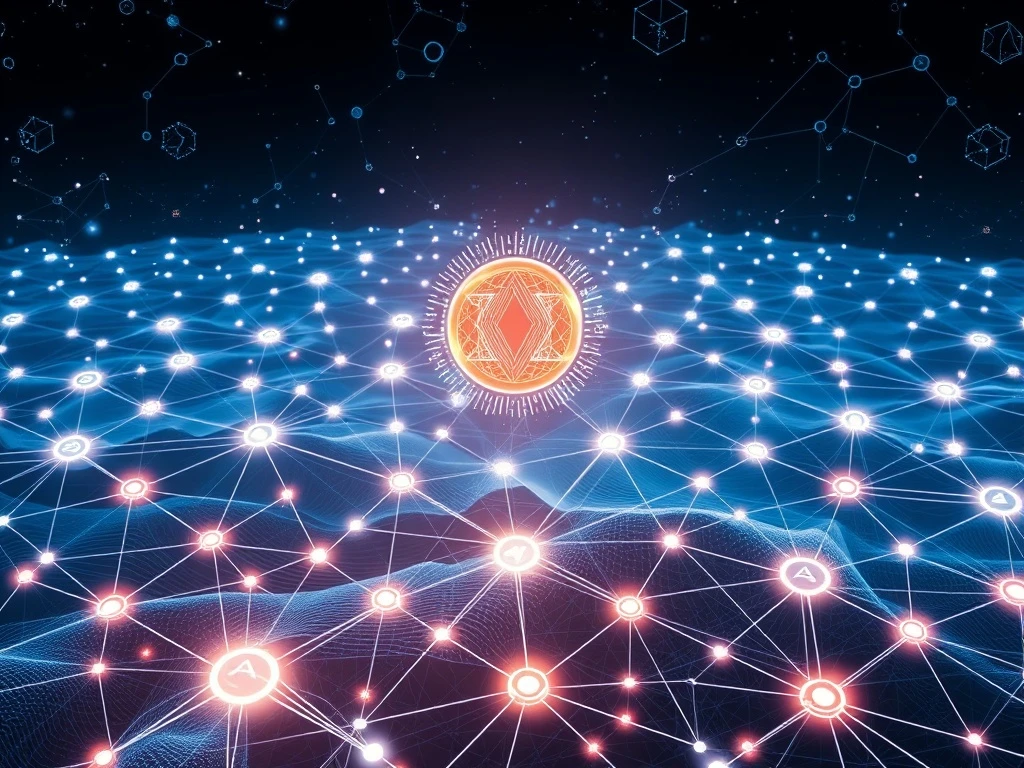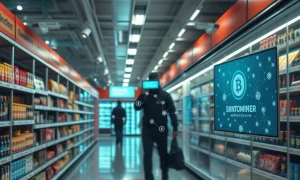In a world rapidly being reshaped by artificial intelligence, a quiet revolution is brewing. We’ve grown accustomed to AI systems operating within the confines of large corporations, often opaque and centralized. But what if AI could be different? What if it were distributed, transparent, and composable, accessible to everyone? This is the ambitious vision driving Vortia AI, a pioneering blockchain startup poised to become the foundational layer for a truly decentralized intelligence economy. For entrepreneurs and innovators, understanding this shift is crucial, as Vortia AI is not just another token; it’s building the infrastructure for the next era of digital intelligence.
Why Vortia AI is Pivoting the Future of Intelligence
Artificial intelligence and blockchain stand as the two most transformative technologies of our time. Yet, their development has largely occurred in separate silos. Centralized AI systems dominate cloud computing, while blockchain protocols often struggle with incorporating complex intelligent automation. Vortia AI seeks to bridge this gap, enabling AI models that can run verifiably, interact seamlessly with smart contracts, and operate across decentralized environments.
Its core thesis is simple yet profound: the future of computation will not just be decentralized, but inherently intelligent. And to support this intelligent future, new infrastructure is essential. Many projects attempt to combine AI and blockchain, but Vortia AI distinguishes itself by offering a full-stack infrastructure, built from the ground up to power real AI systems on-chain, moving beyond mere speculative tokens or abstract ideas.
What Makes Vortia AI a Full-Stack Infrastructure Play?
At the heart of the Vortia AI ecosystem lies Vortiachain, a blockchain meticulously optimized for AI workloads. Unlike general-purpose blockchains with AI add-ons, Vortiachain is purpose-built, designed to support:
- Privacy-preserving inference: Ensuring sensitive data remains secure during AI computations.
- Scalable computation: Handling the intensive processing demands of AI models.
- Real-time AI triggers: Enabling immediate responses and interactions based on AI insights.
This dedication to custom infrastructure, down to its memory architecture and consensus mechanism, sets Vortia AI apart in the decentralized AI landscape. It’s not just a protocol; it’s an entire operating system for decentralized intelligence.
Vortia’s architecture is modular, composed of five main layers, each playing a critical role in its comprehensive vision:
- Vortiachain: A hybrid Proof-of-Stake (PoS) and Delegated Proof-of-Stake (DPoS) blockchain specifically tailored for AI operations.
- AI Marketplace: A decentralized platform for listing and accessing AI services and models.
- Data Gateway: A secure pipeline designed for encrypted data sharing, crucial for privacy.
- AI Oracles: Bridges that enable smart contracts to reliably interact with off-chain AI models and data.
- Vortia SDK: A comprehensive suite of developer tools for building and deploying AI-native decentralized applications (dApps).
This comprehensive approach allows Vortia AI to offer much more than just inference-as-a-service or data staking. It enables the creation of autonomous AI agents that can transact, evolve, and interact intelligently across the Web3 landscape.
Real-World Impact: Where Can Vortia AI Shine?
Vortia AI is focused on building tangible utility. Its roadmap includes testnet, SDK launch, and marketplace rollout all within the next 12 months, prioritizing real-world applications over speculative hype. The project has already mapped out compelling use cases in industries that demand both intelligence and trust:
- Decentralized Finance (DeFi): Enabling predictive analytics, sophisticated risk scoring, and dynamic asset management for more robust and intelligent financial protocols.
- Healthcare: Supporting privacy-preserving diagnostics and federated learning, allowing AI to learn from distributed datasets without compromising patient privacy.
- Smart Cities: Powering decentralized traffic management systems, optimizing energy grids, and enabling real-time environmental monitoring for more efficient and responsive urban environments.
- Logistics: Making supply chains verifiable, transparent, and self-optimizing, improving efficiency and reducing fraud.
These examples highlight Vortia AI’s commitment to addressing complex, real-world problems with its innovative decentralized framework.
Understanding the VAI Token: More Than Just a Crypto Asset
The native token, VAI, is designed to be far more than a simple payment mechanism within the Vortia AI ecosystem. It acts as the crucial coordination layer, powering various functions:
- Staking: Securing the network and incentivizing participation.
- Governance: Allowing token holders to participate in decision-making for the platform’s future.
- Service Access: Providing the means to pay for AI services and models on the marketplace.
- Incentivization: Rewarding participants for contributing to the network and its development.
With 70% of tokens allocated for public sale, Vortia AI is opting for wide distribution over concentrated ownership, a refreshing approach in today’s market often dominated by private funding rounds. Initially, Vortia AI plans to launch on Solana to leverage its liquidity and speed, before migrating to its custom mainnet. This tactical choice allows the project to build market traction and community engagement before fully transitioning to its purpose-built blockchain environment.
The Broader Vision: Why Decentralized AI Matters
The decentralization of AI is not merely a technical challenge; it carries significant political and societal implications. As governments worldwide increasingly advocate for ethical AI and data sovereignty, platforms that inherently offer verifiability, privacy, and governance by design are becoming essential. Vortia AI is making a bold bet that centralized AI will eventually face the same public skepticism and regulatory scrutiny that centralized finance has encountered. It positions itself as a robust, transparent alternative.
Its community-first governance model, open-source architecture, and incentive-aligned tokenomics all point towards a vision that transcends any single use case. It’s about building a more trustworthy, equitable, and resilient future for artificial intelligence.
Final Thoughts
Many projects in the decentralized AI space often fall into one of three categories: overly narrow (focusing only on compute), overly broad (relying heavily on buzzwords), or technically flimsy. Vortia AI stands apart. It is execution-oriented, thoughtfully modular, and already building with a clear eye on real-world deployment and utility. Whether Vortia AI ultimately becomes the ‘Ethereum of decentralized AI’ remains to be seen, but it is unequivocally aiming to be its foundational layer.
In a world where AI is rapidly becoming the new digital oil, owning and controlling the infrastructure that powers it could prove to be the most valuable strategic play of all. Vortia AI is laying the groundwork for that future.
Frequently Asked Questions (FAQs)
Q1: What is Vortia AI’s core mission?
Vortia AI aims to become the operating system for decentralized AI, bridging the gap between artificial intelligence and blockchain technology. Its mission is to enable AI models to run verifiably, interact with smart contracts, and operate transparently across decentralized environments, moving away from centralized AI systems.
Q2: How does Vortia AI bridge the gap between AI and blockchain?
Vortia AI bridges these two powerful technologies through its purpose-built blockchain, Vortiachain, which is optimized for AI workloads. It provides a full-stack infrastructure that allows AI models to run on-chain, ensuring privacy, scalability, and real-time interaction with smart contracts.
Q3: What are the key components of the Vortia AI ecosystem?
The Vortia AI ecosystem is built on five main modular layers: Vortiachain (the core blockchain), an AI Marketplace (for services and models), a Data Gateway (for secure data sharing), AI Oracles (for off-chain AI interaction), and the Vortia SDK (for developer tools).
Q4: What are the primary uses of the VAI token?
The VAI token is the coordination layer for the Vortia AI ecosystem. It is used for staking to secure the network, participating in governance, accessing AI services on the marketplace, and incentivizing network participants. It’s designed for utility and ecosystem coordination, not just as a payment mechanism.
Q5: Why is decentralized AI important, according to Vortia AI’s vision?
Vortia AI believes decentralized AI is crucial because it addresses growing concerns about centralized AI’s ethics, transparency, and data sovereignty. By offering verifiability, privacy, and community governance by design, decentralized AI provides a more trustworthy and equitable alternative to traditional centralized models, mirroring the shift seen from centralized to decentralized finance.
























